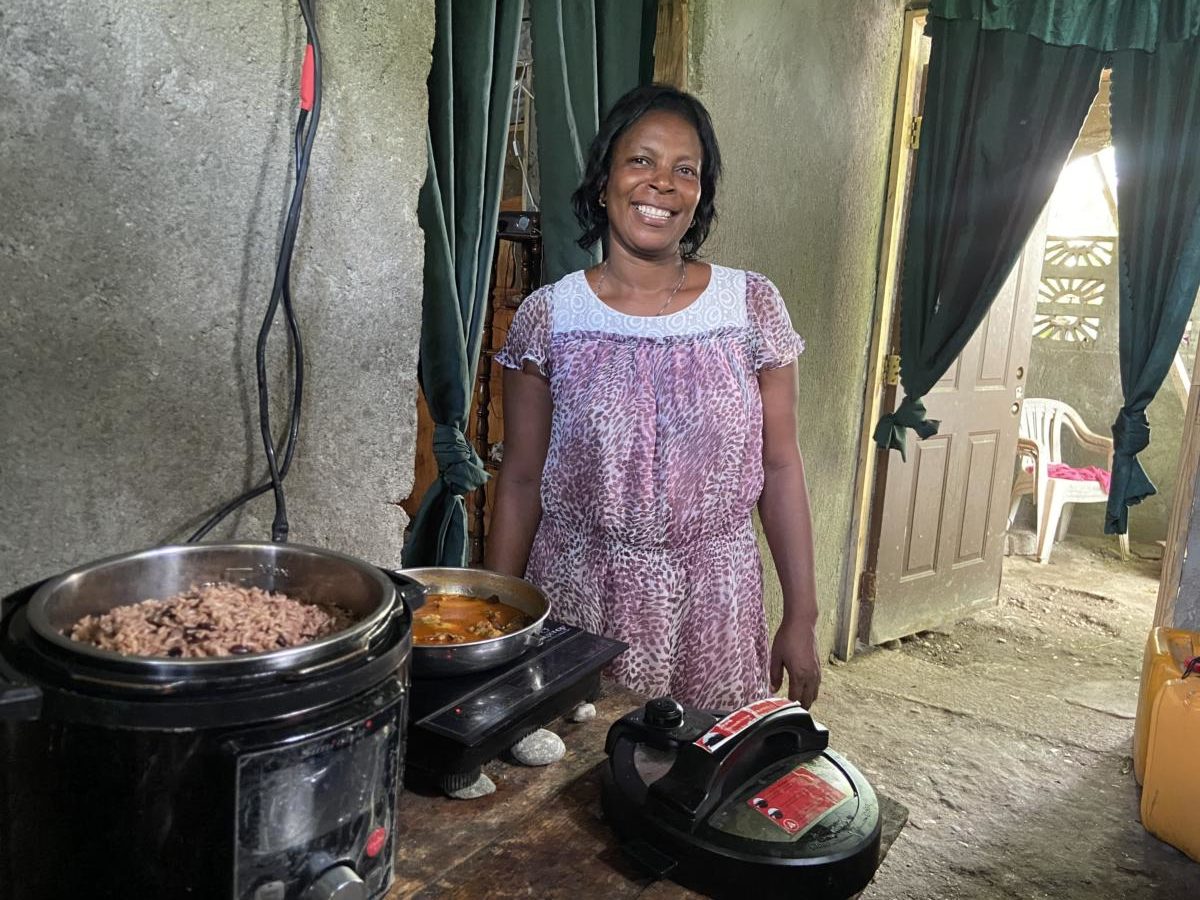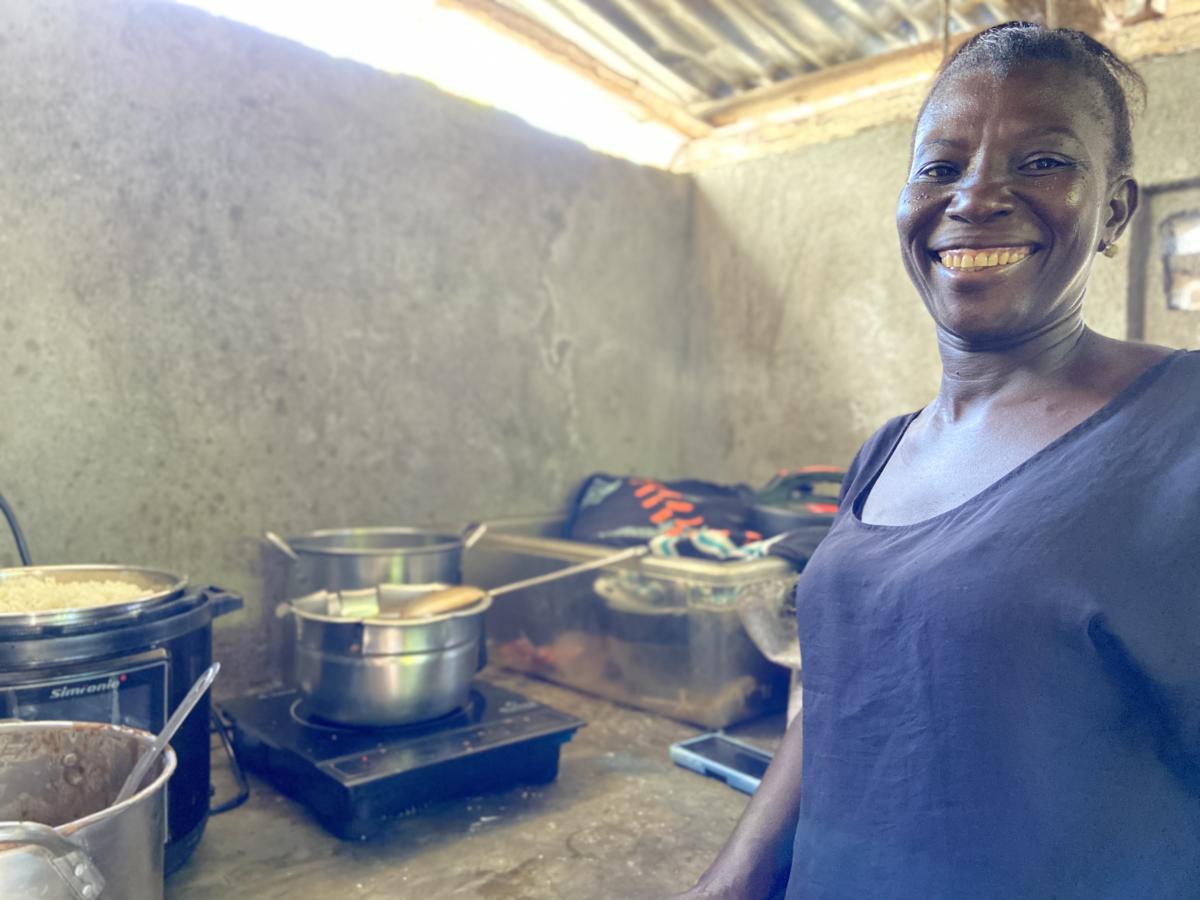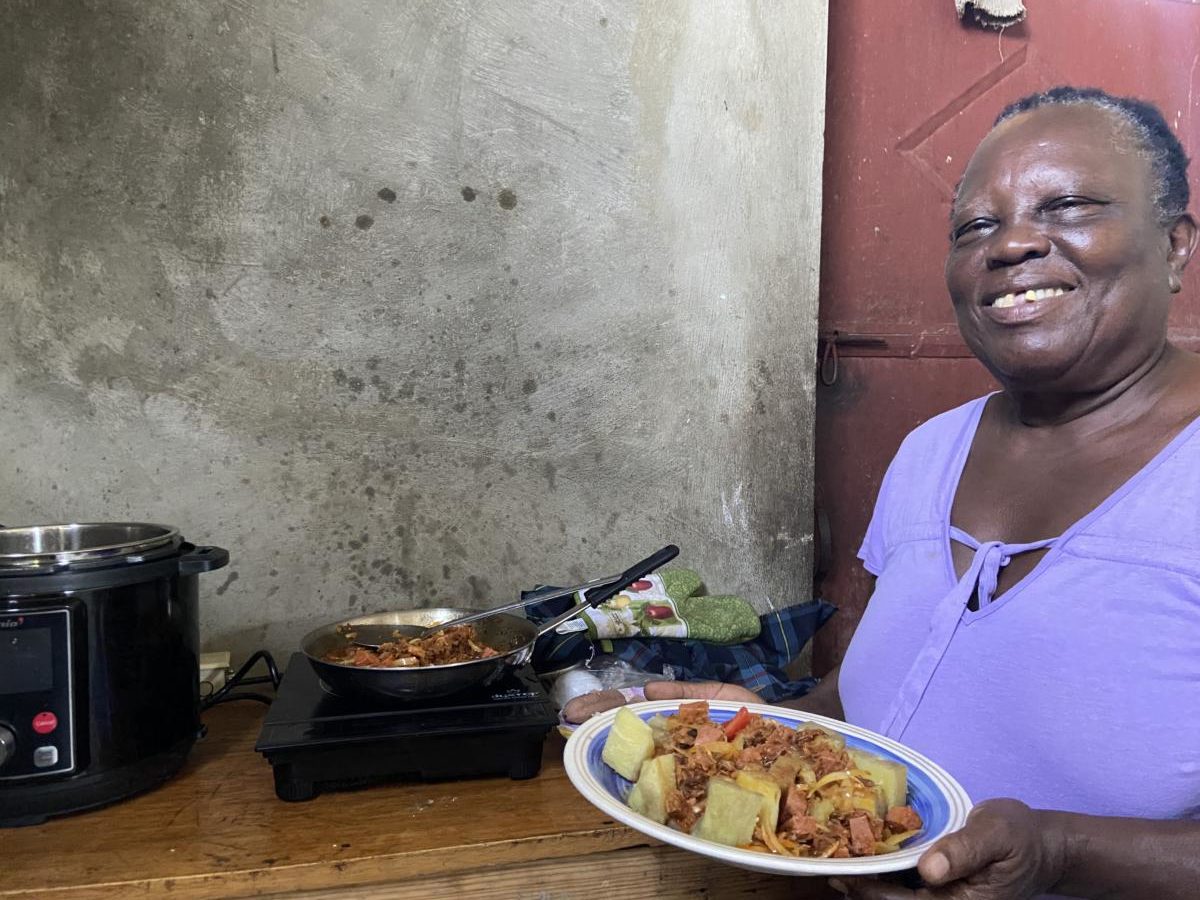A research project in rural Haiti demonstrates the effectiveness of electric cooking technologies powered by solar microgrids to improve the quality of life for community members while generating new revenue streams and opportunities for energy access providers.
Approximately 3 billion people cook today using wood fuels, charcoal, and kerosene in open fires and stoves—methods that produce high levels of household air pollution with health-damaging effects. According to the World Health Organization, about 3.8 million people each year die prematurely from illnesses attributable to household air pollution caused by the use of solid fuels and kerosene for cooking. Exposure is particularly high among women and young children, who spend the most time in domestic spaces.
While energy access worldwide has improved in recent years, the availability of clean fuels and technologies for cooking remains an obstacle to achieving the United Nations Sustainable Development Goal 7, which aims to ensure universal access to affordable, reliable and modern energy services by 2030. In Haiti, an estimated 97.3% of rural households rely on solid fuels for household cooking and cooking indoors (63%) and on unvented cookstoves or over open flames.
Researchers have identified electric cooking as a key opportunity for clean cooking in developing communities. Initial research indicates that microgrids, in particular, represent a key opportunity for electric cooking as they can leverage critical economies of scale and utility business models to support electric cooking investment for customers and the cooking load can in turn help provide additional revenue streams for microgrid financial viability.
In 2012, in partnership with the Government of Haiti, local officials, and the UN Environmental Program, EarthSpark International, a non-profit organization working to expand energy access in underserved communities, launched a microgrid in the town of Les Anglais, Haiti. The recently expanded system is a solar-powered smart grid that serves 450 households and small businesses (over 2,250 people). It is powered by a state-of-the-art hybrid generation system that includes 93 kWp of PV capacity, 205.5kWh of battery capacity and a small diesel backup generator. The system provides affordable, reliable electricity service through Enèji Pwòp – EarthSpark’s spin-off social enterprise and microgrid operator in Haiti.

EarthSpark Deploys Electric Cooking Pilot Project in Haiti
EarthSpark recently partnered with the UK Government’s Modern Energy Cooking Services (MECS) initiative to establish an electric cooking program in solar microgrid communities in rural Haiti.
Twenty households already connected to EarthSpark’s solar-powered smart grid in rural Haiti signed up to trial electric pressure cookers and induction stoves with integrated smart meters. Additionally, eight off-(micro)grid households joined the trial with SUNSPOT™ novel solar home cooking systems. Leveraging detailed smart meter consumption data and energy/food journals from the 28 households, the project’s results offer a baseline for electric cooking in Haiti and beyond.
The team installed electric cooking devices and tracked electric cooking practices and preferences for three months. The study utilized a combination of data sources to provide a holistic assessment of electric cooking including 15-minute interval electricity consumption data from SparkMeter smart meters, energy diaries where participants recorded daily meals, people served, and fuel use, as well as formal participant surveys and interviews both before and after project implementation.
Results Reveal Benefits for Community and Microgrid Operators
The project demonstrated that electric cooking can not only be effectively integrated into solar microgrid models for energy access, but also can help drive socio-economic development for participants and improved operations for microgrid models.
Electric cooking increased the overall load for the solar microgrid by about 20%, but from 8 AM to 2 PM hourly microgrid load increased 42%-55%. In fact, the majority of electric cooking consumption (61%) occurred between 9 AM and 4 PM, which researchers explain aligns extremely well with high solar production for the grid. On normal sunny days, the microgrid has enough extra solar + storage capacity to absorb the cooking load, particularly since it is aligned in the middle of the day, but when solar production is low due to cloudy days and rain, the microgrid has seen increased diesel generator usage and on a few occasions blackouts due to overdraw of the generator.
At the highest level, monthly generator use increased 33% from the start of the cooking pilot in July to the end of October. It should be noted that other significant loads were added to the Les Anglais system in July 2020 when the electric cooking pilot started, in particular two telecommunications towers which were themselves a significant draw on the system, so the increase in generator use is not only attributed to electric cooking.

Researchers offered free electricity for electric cooking to the participants in order to prioritize actionable data and results for planning electric cooking. However, from the participants’ reported charcoal savings the project did highlight an overall indicative willingness to pay around 30.76 htg/kWh (~0.38 USD/kWh as of April 2021) with 13 of the participants reporting an indicative tariff at or above existing EarthSpark tariffs. EarthSpark is currently working to develop follow-up econometric studies to explore optimized pricing structures and business models for electric cooking.
Another notable benefit from the study for the off-grid households was the SUNSPOT system’s 3rd outlet (USB and AC outlet) that supports basic energy access needs. Community members utilized this feature for lighting, small radios, and cell phone charging.
Electric Cooking Improves Quality of Life by Saving Time and Supporting Health
The biggest impact noted by participants has been the time savings of electric cooking compared to traditional fuels. For this pilot, electric cooking reduced the time burden of cooking 32-53% for staple foods in Haiti resulting in extra time for leisure, income, education and family, particularly for women.
The electric cooking solutions also improved the convenience of cooking. Traditionally, community members burn charcoal in an outdoor/separate kitchen area, which can make cooking in the middle of the night or in inclement weather inconvenient. In comparison, the clean electric cooking appliances are located inside the house, making it easier for users to prepare food at any hour.
The electric cooking deployments also significantly reduce the risk of household air pollution. Though not quantified specifically, participants highlighted the health and convenience benefits of removing smoke and heat impacts from their cooking tasks, citing fewer illnesses.
Electric Cooking Represents a Pathway to Improved Microgrid Service
Overall, electric cooking was a great success from the energy system operator point of view as well. The pilot demonstrated that electric cooking can leverage existing capacity and logistics to enhance the value proposition of integrated electrification to customers and add an additional revenue stream for microgrid operators. Electric cooking also reduces GHG emissions from baseline fuels (a key metric for microgrid regulators and investors) and further allows for greater utilization and reduced curtailment of installed solar as cooking profiles in Haiti align with solar production.
By its nature, electric cooking also becomes an energy-dense deferrable load for microgrid operations and planning. This is critically important as it allows operators to increase system sizing and improve reliability of service for all customers, especially when considering the 100% renewable microgrid systems supported by demand-side management and distributed energy resources that EarthSpark will install as part of its expansion plans. In the future, the organization hopes to design the specific tariffs and incentives to develop the specific business model for electric cooking.
The biggest barrier to electric cooking in solar microgrid communities is the initial capital cost of the cooking devices. The EarthSpark team believes that utilizing microgrid models to mobilize blended financing particularly for results-based financing streams for health and development outcomes might present an attractive opportunity for scaling electric cooking if the viability can be demonstrated for donors and social impact investors. Further, pay-as-you-save models where the appliance capital costs are paid off initially using customers’ charcoal savings may also work if the savings margins are high enough with the rising cost of charcoal.

Integrating Electric Cooking into Microgrid Scale-Up
Overall, electric cooking has been shown as an attractive and viable pathway for EarthSpark’s microgrids to explore further with future projects and deployments most notably as part of their $43 million microgrid expansion project with the Green Climate Fund which will develop an additional 22+ 100% solar microgrids in Haiti over the next five years.
The pilot study created baseline data on electric cooking load profiles, peak demand, appliance usage, and customer behavior that EarthSpark is directly integrating into its modeling for future microgrids. Specifically, EarthSpark is using the HOMER platform to design and size the 100% renewable microgrids to include new customer classes for typical electric cooking usage as well as dispatchability and demand-side management for electric cooking.
Formalizing the electric cooking load in the HOMER platform provides EarthSpark with additional flexibility to model how electric cooking load interacts with other customer consumption and how microgrid systems need to be sized to support the added dynamic load. Furthermore, this HOMER integration provides additional confidence for both EarthSpark and its donors and investors about electric cooking being deployed at scale in EarthSpark’s planned microgrids. In total, EarthSpark is planning to expand electric cooking service to over 1,500 households (approximately 7,500 people) representing over 1 GWh in annual electricity consumption (and revenue) for EarthSpark’s microgrids.
To complement the pilot program, EarthSpark is partnering with local and international cookers of Haitian cuisine to launch an online social media community known as “Kwison Elektrik”. The community will offer electric cooking stories, recipes and photos both from those cooking on EarthSpark grids and also from the broader community of people who cook or appreciate Haitian food.
Overall, the pilot represents a successful first step to prove the viability, effectiveness and attractiveness of electric cooking technologies powered by robust, reliable solar microgrids and other solar+storage energy systems supporting critical socioeconomic development outcomes in Haiti. In doing this, the project is demonstrating a justification for microgrid developers, policy-makers and funders to explore building more robust infrastructure that has previously been standard in order to solve the various energy access needs in rural communities.

UL Solutions’ HOMER® Pro is the leading pre-feasibility design software for modeling microgrids, with more than 250,000 users in more than 190 countries. It provides engineering and financial analyses of remote, off-grid and grid-tied complex distributed energy systems, helping reduce financial risk for owners and developers. Learn more about HOMER Pro and download a complimentary trial.
